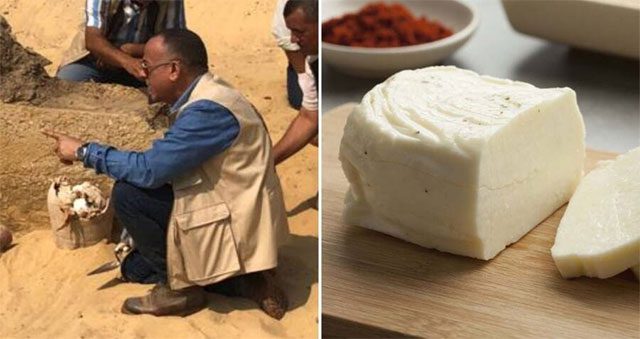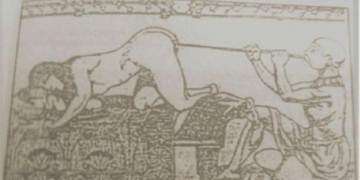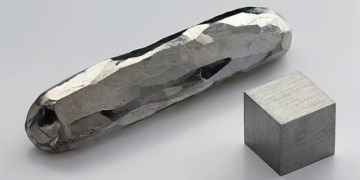Indian archaeologists have discovered halloumi cheese dating back approximately 2,600 years, stored in clay jars adorned with Demotic script.
Researchers working at a site in Giza, Egypt, recently reported a surprising find. Within the ancient clay jars decorated with Demotic writing—a script used by ancient Egyptians found on the famous Rosetta Stone—they uncovered blocks of white cheese dating back 2,600 years.
According to Egypt Today, the cheese was excavated from the Saqqara cemetery.
The Egyptian Ministry of Tourism and Antiquities noted that this site is particularly significant as it contains relics and tombs from various eras, temples from the 6th Dynasty of the Pharaonic period, numerous animal statues, and two papyrus scrolls measuring 32 feet (nearly 10 meters) in length.

Cheese placed in ancient clay jar decorated with Demotic script
Mohammad Youssef Oyan, Director of the Saqqara Antiquities, explained that many valuable items were left in ancient tombs as offerings to accompany the deceased in the afterlife. In this case, the cheese served as such an item.
The ancient cheese dates back to around the 26th Dynasty of Egypt, approximately between 664 and 525 BC.
According to Ancient Origins, the cheese has been identified as halloumi, a traditional cheese from Cyprus made from a mixture of goat, sheep, and sometimes cow’s milk. It is known for its texture similar to mozzarella. Modern halloumi is often made entirely from cow’s milk due to its availability and lower cost.
Halloumi is believed to have become extremely popular in Eastern Mediterranean cultures. It was first recorded in a 16th-century report by an Italian traveler to Cyprus. However, the true origins of the cheese remain a mystery.
This new discovery marks the second time ancient cheese has been found in the area. The first was uncovered during an archaeological dig in 2018 and was dated to 3,200 years ago.
This initial discovery was significant as it provided the first evidence of cheese production by ancient Egyptians.
Enrico Greco from the University of Catania stated: “The materials analyzed are likely the oldest archaeological solid waste ever found. We know it was primarily made from sheep and goat milk, but for me, it’s hard to imagine a specific flavor.” However, Professor of Chemistry and cheese historian Paul Kindstedt told the New York Times that the cheese could be “truly sour.”
Alongside the ancient cheese, researchers also found traces of bacteria that they believe could cause brucellosis, an infectious disease from consuming unpasteurized dairy products. Symptoms of brucellosis include fever, sweating, and muscle pain, similar to flu symptoms.
This disease still exists today, but the ancient bacteria found in the tomb marks the earliest appearance of this illness.
Since 2018, research teams at the Saqqara necropolis have excavated a wealth of artifacts and sarcophagi.
The research team has only been working at the Saqqara site since 2018, but aside from the ancient cheese, they have made many significant discoveries. The largest find to date occurred in 2020 when they discovered over 100 Late Period sarcophagi buried in a well, still in pristine condition.
At the same time, the team also found 40 statues of Ptah Suker, the god of the Saqqara necropolis, and 20 wooden boxes dedicated to Horus, the Egyptian god of war and the sky.
As of May 2022, 250 well-preserved mummies have been found and displayed at Saqqara.





















































